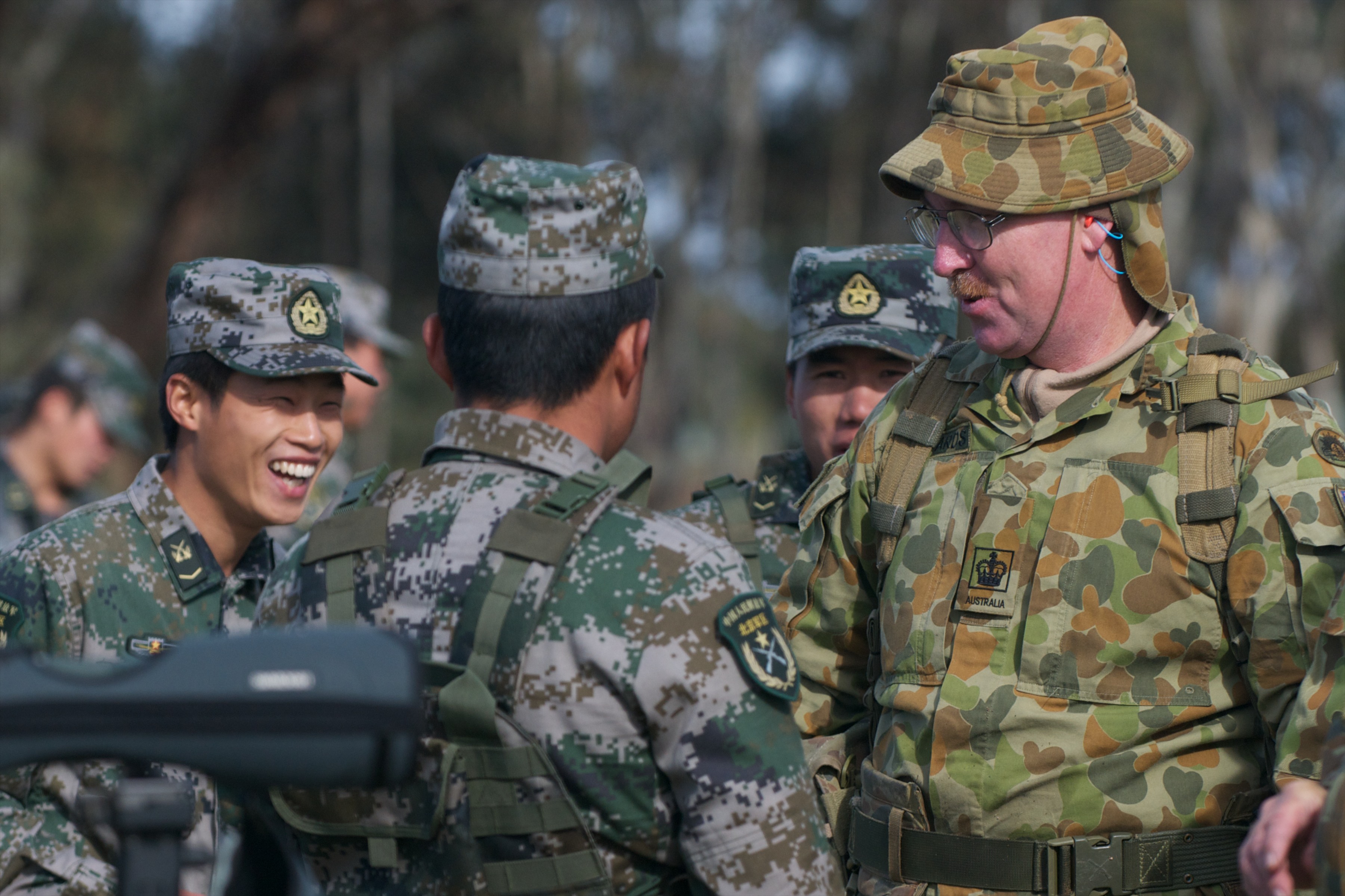Australia’s defence engagement in the context of Asian power shifts
Posted By Benjamin Schreer on July 26, 2013 @ 14:30
ASPI’s new report [2] on Australia’s regional defence diplomacy focuses on assisting countries in our near region with military capacity building. I fully agree with my colleagues and the 2013 Defence White Paper [3] (DWP) that defence engagement can be particularly helpful in improving the security of Pacific Island countries.
But I’m not as convinced of the value of defence diplomacy in the wider region, especially amidst the power shifts taking place in the ‘Indo-Pacific’ region, including in Southeast Asia. The main reason is that China’s strategic rise and its challenge to the existing regional security order, currently centred on America’s military presence, will add a degree of competition to defence relations that isn’t found in our near region. In short, it adds a much more competitive dimension to defence diplomacy, and Australia would be well advised to consider this when crafting its future defence engagement activities.
Let’s start with the good news: greater major power competition in Asia opens up avenues for Australia to use trilateral defence engagement with the US and China to building greater trust between the two major powers and with the PLA. Since US–China strategic relations remain underdeveloped, both sides look to use multilateral exercises as an indirect approach to ease bilateral suspicion and to build greater trust. As I argued here [4] earlier, China and the US could therefore be sympathetic to Australian initiatives for trilateral exercises. However, we need to be realistic; defence engagement between the US and China (with Australia in a facilitating role) won’t resolve their structural disagreement over hegemonic leadership. Indeed, neither Washington or Beijing has high expectations that defence diplomacy will be of much help in times of serious crisis [5].
The more competitive nature of defence diplomacy in Asia will also play out on the level of other major Asian powers such as Japan and India. In the face of a more assertive China, they’re seeking to diversify their defence engagements as part of a hedging strategy—and they look to Australia to play a role in these efforts. While Japan’s Prime Minister Shinzo Abe no longer openly promotes his idea of ‘Asia’s Democratic Security Diamonds [6]’, e.g. Australia, Japan, India, and the US safeguarding the maritime commons, Tokyo’s angst about China’s strategic trajectory has led to intensified efforts to increase defence cooperation with ‘like-minded’ countries. One outcome is closer defence ties with India [7]. Another is Japanese assistance to The Philippines in building up its maritime capabilities. Our American ally supports Japan’s more active defence diplomacy and, among other things, is pushing for an increase of trilateral US-Japan-Australia military exercises to break-up Tokyo’s traditional preference for bilateral exercises.
India might also gradually look more towards Australia as a defence cooperation partner to increase its strategic options. Delhi’s recent border dispute with Beijing has only increased Indian concerns about China’s real intentions. A recent conference of the Center for a New American Security (CNAS), an influential Washington think-tank, discussed the merits of greater maritime cooperation between Australia, Japan and India [8]. If there’s any substance in the ‘Indo-Pacific’ concept, trilateral maritime defence activities involving Australia, India and Indonesia [9] would make perfect sense. And trilateral defence activities involving India, Australia and another party might be more attractive to the Indians than bilateral engagements. The Asian power shifts therefore makes Australia a more attractive defence cooperation partner for the regional major powers, opening up new avenues for defence engagement. At the same time the ‘China dimension’ behind some of those activities can’t be wished away. That’s the bad news—defence engagement in a competitive region necessarily entangles us in major power plays.
And we could get caught up in positioning moves by regional middle powers as well. The new DWP makes much of improving defence engagement in Southeast Asia, but this objective could actually become the most challenging. Southeast Asia is rapidly developing into an arena for major power competition, fuelled by regional anxieties over China’s inclination to assert its ‘indisputable sovereignty’ in the South China Sea. Thus, for an increasing number of Southeast Asian countries, a key criteria for defence diplomacy with external actors is how it contributes to their strategic capabilities against Chinese maritime assertiveness. The Philippines, for example, clearly increased defence cooperation with the US and Japan to hedge against China [10], and looks towards Australia with the same goal in mind. Vietnam [11] could also go down that path.
That’s if we get to be involved to any great extent. Defence diplomacy in Southeast Asia will be increasingly about building-up war-fighting capabilities. Australia is at serious risk of being crowded out of a tougher Southeast Asian defence diplomacy market as regional countries have a greater range of external partners to choose from. Even in places such as Indonesia, Australia not only competes with players such as China and Russia but also with the US. Our traditional focus on staff exchanges and lower-level capacity-building might no longer be enough.
All this isn’t an argument against the value of defence diplomacy to secure Australia’s strategic interests. But it’s a reminder that, in a more competitive Indo-Pacific strategic environment, it might be much harder to do and more consequential if we succeed.
Benjamin Schreer is a senior analyst at ASPI. Image courtesy of Department of Defence [12].
Article printed from The Strategist: https://www.aspistrategist.org.au
URL to article: https://www.aspistrategist.org.au/australias-defence-engagement-in-the-context-of-asian-power-shifts/
URLs in this post:
[1] Image: http://www.aspistrategist.org.au/wp-content/uploads/2013/07/20130516adf8225051_80.jpg
[2] ASPI’s new report: http://www.aspi.org.au/publications/publication_details.aspx?ContentID=365&pubtype=5
[3] 2013 Defence White Paper: http://www.defence.gov.au/whitepaper2013/
[4] here: http://www.aspistrategist.org.au/a-glass-half-full-us-china-strategic-dialogue/
[5] much help in times of serious crisis: http://www.nbr.org/publications/element.aspx?id=653#.Ue9QOtIwdRs
[6] Asia’s Democratic Security Diamonds: http://www.project-syndicate.org/commentary/a-strategic-alliance-for-japan-and-india-by-shinzo-abe
[7] closer defence ties with India: http://thediplomat.com/2013/07/17/japan-india-security-cooperation/
[8] greater maritime cooperation between Australia, Japan and India: http://thediplomat.com/the-naval-diplomat/2013/07/21/strategic-triangle-a-japan-australia-india-coalition-at-sea/
[9] trilateral maritime defence activities involving Australia, India and Indonesia: http://www.lowyinstitute.org/publications/two-nations-take-lead-securing-indo-pacific-century
[10] clearly increased defence cooperation with the US and Japan to hedge against China: http://thediplomat.com/2013/07/23/the-philippines-search-for-strategic-partners/
[11] Vietnam: http://csis.org/publication/pacnet-56-vietnams-president-visiting-white-house-talk-strategy
[12] Department of Defence: http://images.defence.gov.au/20130516adf8225051_80.jpg
Click here to print.
